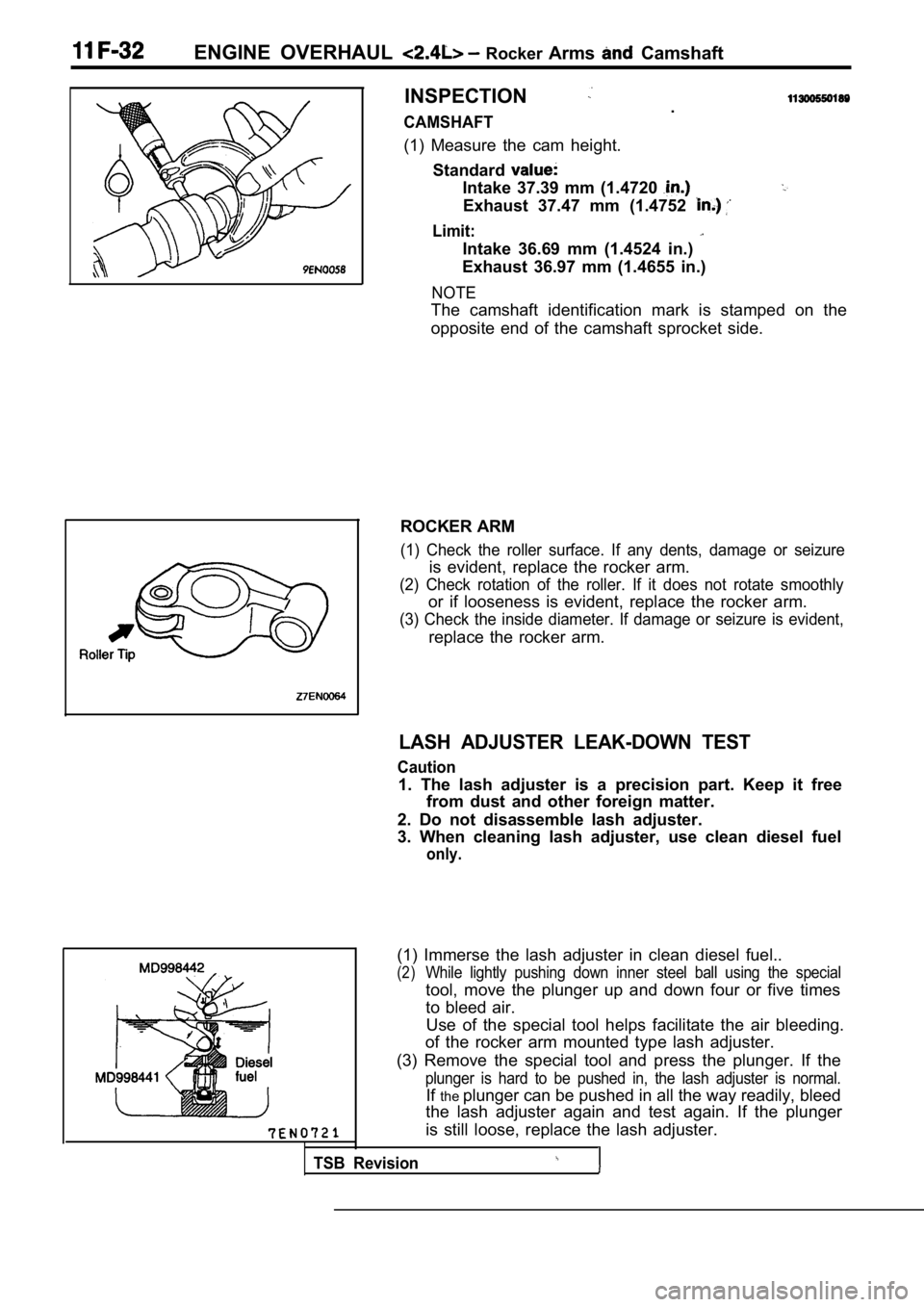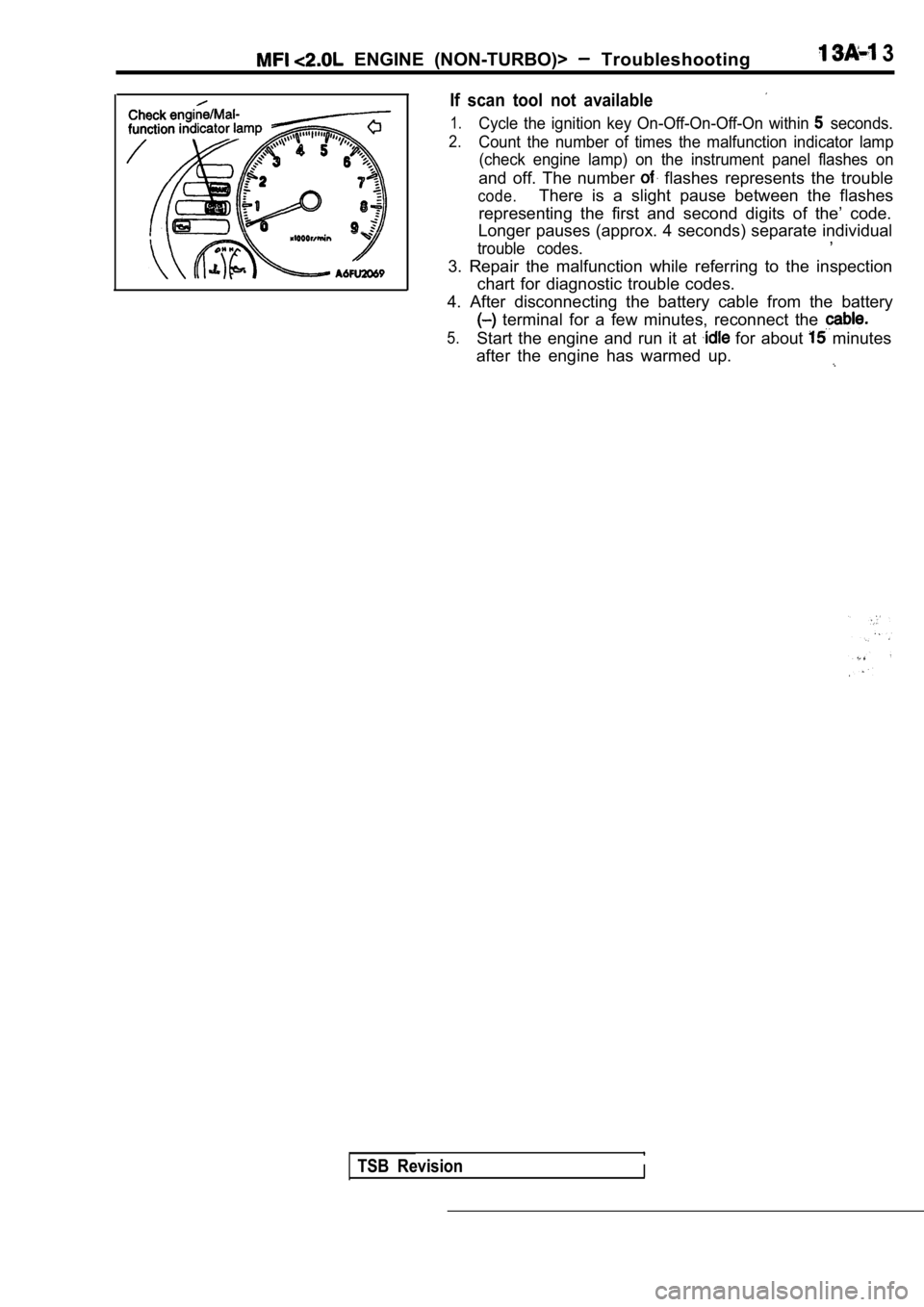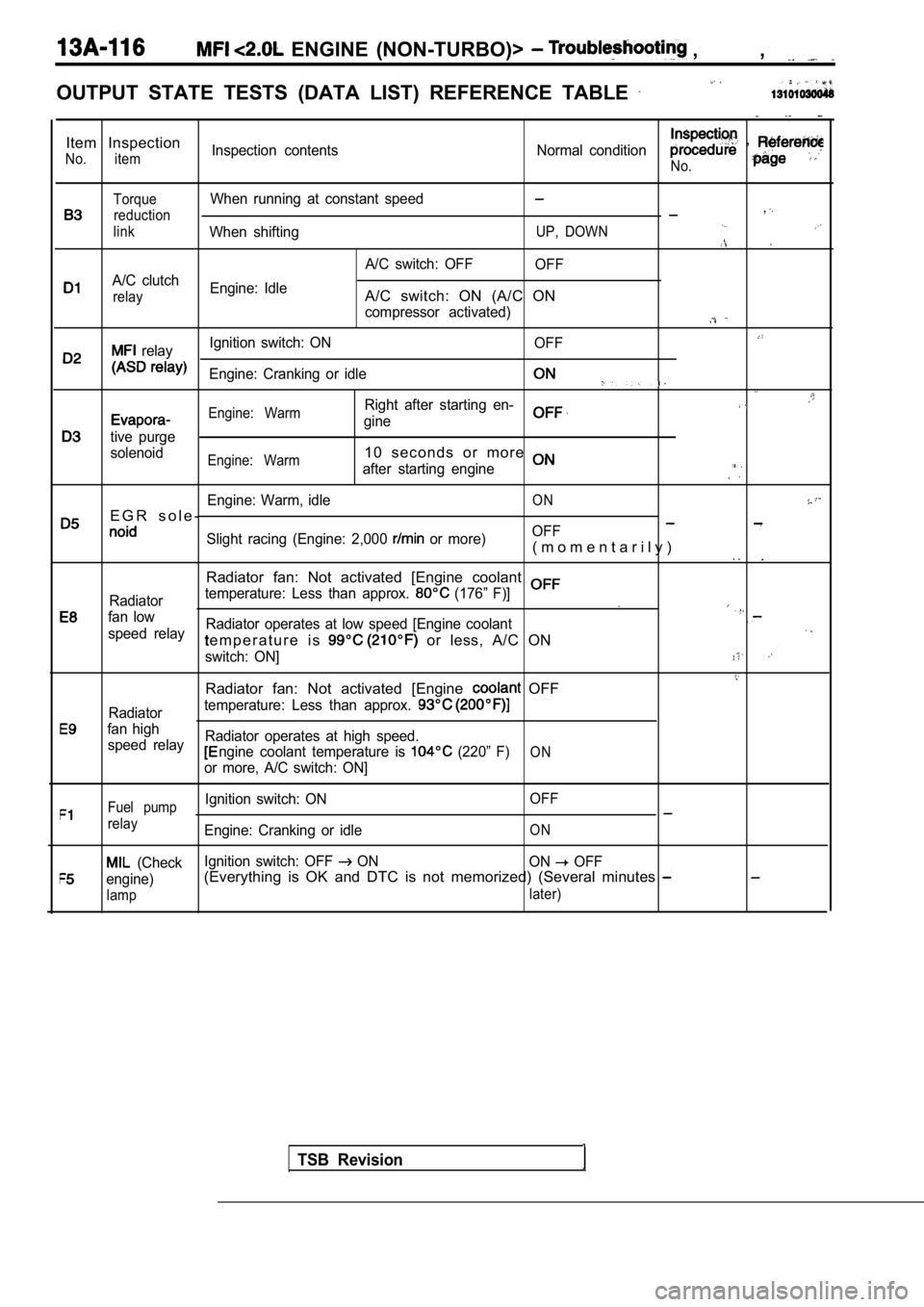1990 MITSUBISHI SPYDER check engine light
[x] Cancel search: check engine lightPage 342 of 2103

ENGINE OVERHAUL Rocker Arms Camshaft
I
INSPECTION
CAMSHAFT.
(1) Measure the cam height. Standard
Intake 37.39 mm (1.4720
Exhaust 37.47 mm (1.4752
Limit:
Intake 36.69 mm (1.4524 in.)
Exhaust 36.97 mm (1.4655 in.)
NOTE
The camshaft identification mark is stamped on the
opposite end of the camshaft sprocket side.
ROCKER ARM
(1) Check the roller surface. If any dents, damage or seizure
is evident, replace the rocker arm.
(2) Check rotation of the roller. If it does not rotate smoothly
or if looseness is evident, replace the rocker arm.
(3) Check the inside diameter. If damage or seizure is evident,
replace the rocker arm.
LASH ADJUSTER LEAK-DOWN TEST
Caution
1. The lash adjuster is a precision part. Keep it f ree
from dust and other foreign matter.
2. Do not disassemble lash adjuster.
3. When cleaning lash adjuster, use clean diesel fu el
only.
Use of the special tool helps facilitate the air bleeding.
of the rocker arm mounted type lash adjuster.
(3) Remove the special tool and press the plunger. If the
plunger is hard to be pushed in, the lash adjuster is normal.
Ifthe plunger can be pushed in all the way readily, bleed
the lash adjuster again and test again. If the plun ger
is still loose, replace the lash adjuster.
TSB Revision
(1) Immerse the lash adjuster in clean diesel fuel. .
(2)While lightly pushing down inner steel ball using t he special
tool, move the plunger up and down four or five tim es
to bleed air.
Page 391 of 2103

ON-BOARD DIAGNOSTICS
The
Control Module (PCM) monitors
many different circuits in the fuel injection syste m.
If the PCM senses a problem with a monitored
circuit often enough to indicate an actual problem,
it stores a diagnostic trouble code in the
memory.
After the PCM first detects a malfunction, a
diagnostic trouble code is recorded when the engine
i s r e s t a r t e d a n d t h e s a m e m a l f u n c t i o n i s
re-defected. However, for items marked with a
a diagnostic trouble code is recorded the
first detection of the malfunction.
After that, if the PCM does not re-detect the
malfunction for 40 drives* (51 engine start for
non-emission related faults), the diagnostic troubl e
code will be erased from the PCM memory.
NOTE
A drive indicates from engine start to stop and
monitors the power train component.
However, for misfiring or a fuel system rich/lean,
the diagnostic trouble codes will be erased under
the following conditions.
lWhen driving conditions (engine speed, engine
coolant temperature, etc.) are similar, to those
when the malfunction was first recorded.
l When the PCM does not re-detect the
malfunction for 80 drives*.
Technicians can display stored diagnostic trouble
codes by two different methods.
ENGINE (NON-TURBO)> Troubleshooting
The first is to cycle the ignition switch
On-Off-On-Off-On within 5
Then count
the number of times the malfunction indicator lamp
(check engine lamp) on the instrument panel flashes
on and off. The number of flashes represents the
diagnostic trouble code. There is a slight pause
between the flashes representing the first and
second digits of the code. Longer pauses separate
individual trouble codes. The second method of
reading diagnostic trouble codes uses
scan
Connect the scan tool to the
(diagnostic) connector in the vehicle.
FREEZE FRAME DATA
The PCM records the diagnostic trouble code and
also the engine operating conditions the time
the malfunction was detected. are called
“freeze frame” data.
This data indicates the engine operating condition
from when nothing at all is the initial
detection of the
However, misfiring
or fuel trim malfunction data are always. replaced
with the latest data.
This data can be read by using the scan tool, and
can then be used in simulation tests for
troubleshooting.
Data items are as follows.
DataUnit
Engine coolant temperature
Engine speed
Vehicle speed
or
or RPM
km/h or mph
Long-term fuel compensation (Long-term fuel trim)
Short-term fuel compensation (Short-term fuel trim)
Fuel control condition O p e n l o o p
l Closed loop
l Open loop-Drive condition
l Open loop-DTC set
lMalfunction of closed (rear)
Calculated load value
MAP vacuum
(vacuum)
Diagnostic trouble code during data recording
TSB Revision
Page 393 of 2103

ENGINE (NON-TURBO)> Troubleshooting 3
If scan tool not available
1.Cycle the ignition key On-Off-On-Off-On within seconds.
2.Count the number of times the malfunction indicator lamp
(check engine lamp) on the instrument panel flashes on
and off. The number flashes represents the trouble
code.There is a slight pause between the flashes
representing the first and second digits of the’ co de.
Longer pauses (approx. 4 seconds) separate individu al
,
trouble codes.
3. Repair the malfunction while referring to the in spection
chart for diagnostic trouble codes.
4. After disconnecting the battery cable from the b attery
terminal for a few minutes, reconnect the
5.Start the engine and run it at for about minutes
after the engine has warmed up.
TSB RevisionI
Page 405 of 2103
![MITSUBISHI SPYDER 1990 Service Repair Manual ENGINE (NON-TURBO)>
C h a r g i n g T o o
47
[Comment]
Background
The PCM tries to maintain charging system voltage of between and 15 volts.
l This code indicates:
The batte MITSUBISHI SPYDER 1990 Service Repair Manual ENGINE (NON-TURBO)>
C h a r g i n g T o o
47
[Comment]
Background
The PCM tries to maintain charging system voltage of between and 15 volts.
l This code indicates:
The batte](/manual-img/19/57345/w960_57345-404.png)
ENGINE (NON-TURBO)>
C h a r g i n g T o o
47
[Comment]
Background
The PCM tries to maintain charging system voltage of between and 15 volts.
l This code indicates:
The battery voltage input is below the target charg ing voltage during engine
andNo significant change in voltage has been detected during active testing of the generator
output circuit.
Range of Check
lEngine speed: or more for approx. one minutelBattery positive voltage is at least 1 lower than the target charging voltage for approx.60 seconds.Set ConditionlBattery positive voltage does not change even if th e generator field current is cut off.
lDefects in generator or adjustmentl High resistance generatorl High between battery and
generator ground
l PCM
Check that the generator drive belt is properly in stalled. Repair
NG Measure the voltage between the generator terminal and the battery positive terminal. Engine: 1600 Headlight: High beam ON)
OK: Less than
Check the harness wire and terminal generator terminal and battery necessary.
NGMeasure the voltage between the generator body and battery Check the generator grounded line: neoative terminal. Engine: 1600 Headlight: High beam ON)
OK: Less than 0.5
OK
Measure at the generator lDisconnect the connector, and measure at the harnes s side.
SCAN TOOL Actuator test 10
relay (ASD relay) isturnedonandoff everyapprox. l Voltage between 1 and ground
[Measure when the relay (ASD relay) is turned on.]
OK: Battery positive voltage
NG Check the wire between generator relay
(ASD relay) connector. Repair, if necessary.
OK
Check the harness wire NG Repair connector.I
OK NG
SCAN TOOL SENSOR READ TEST (Data list) Check the harness wire between the PCM and the bat tery 10 Battery voltage as the ignition switch. Repair, if necessary.OK: indicated on the scan tool and actual positive
Check trouble symptom.
TSB RevisionI
Page 460 of 2103
![MITSUBISHI SPYDER 1990 Service Repair Manual ENGINE (NON-TURBO)>
Scan tool 160
Code General scan tool EVAP Leak Monitor
No.Detected
31
[Comment]
Background
l The PCM monitors that the fuel tank, purge lines, e tc. are MITSUBISHI SPYDER 1990 Service Repair Manual ENGINE (NON-TURBO)>
Scan tool 160
Code General scan tool EVAP Leak Monitor
No.Detected
31
[Comment]
Background
l The PCM monitors that the fuel tank, purge lines, e tc. are](/manual-img/19/57345/w960_57345-459.png)
ENGINE (NON-TURBO)>
Scan tool 160
Code General scan tool EVAP Leak Monitor
No.Detected
31
[Comment]
Background
l The PCM monitors that the fuel tank, purge lines, e tc. are well.
l
ventilation solenoid with the canister ventilation valve (incorporated in the lIf the fuel tank and purge lines are sealed the pressure will rise well by the solenoid specific timeslAfter the pressure rises well, the diaphragm inside the solenoid will not work any more.lIf the purge air leaks slightly, the solenoid will be activated more than specific times.
Range of Check, Set Condition
l The solenoid has been activated more than specific times.
‘ P r o b a b l e
I,
l Fuel tank cap screwed on l tank and purge lines, l Evaporative emission failed
l
l PCM failed’
NGCheck the evaporative Replace
(Refer to GROUP Emission Control System.)
OK
Check the evaporative emission purge solenoid.NG Replace
(Refer to GROUP 17 Emission Control System.)
OK
Check the fuel tank and purge line for leakage.
Scan tool 161
Code General scan tool EVAP Leak Monitor Large Leak
No. Detected
TSB Revision
[Comment]
l The PCM monitors that the fuel tank, purge lines, e tc. are well.
l
ventilation with the canister ventilation valve (incorporated in the solenoid) lIf the fuel tank and purge lines are sealed correct ly, the pressure will well by the solenoid specific times.lAfter the pressure rises well, the diaphragm inside the solenoid will not work any more.lIf the purge air leaks excessively, the solenoid should be activated much more than specific
times.
of Check. Set Condition
l been activated much more than specific times.
Probable cause
l Fuel tank filler cap screwed on lFuel tank and purge seated
l Evaporative solenoid
failed
l
l PCM ,
Check the evaporative emission ventilation solenoid .
(Refer to GROUP 17 Emission Control System.) Replace
NGCheck the evaporative emission purge solenoid. Replace
(Refer to GROUP 17 Emission Control System.)
OK
Check the fuel tank and line for I
Page 468 of 2103
![MITSUBISHI SPYDER 1990 Service Repair Manual ENGINE (NON-TURBO)=,
INSPECTION PROCEDURE 6
Fires up and dies.P r o b a b l e
[Comment]l of the ignition system
In such cases as the above, the cause is probably t hat the spark plugs are MITSUBISHI SPYDER 1990 Service Repair Manual ENGINE (NON-TURBO)=,
INSPECTION PROCEDURE 6
Fires up and dies.P r o b a b l e
[Comment]l of the ignition system
In such cases as the above, the cause is probably t hat the spark plugs are](/manual-img/19/57345/w960_57345-467.png)
ENGINE (NON-TURBO)=,
INSPECTION PROCEDURE 6
Fires up and dies.P r o b a b l e
[Comment]l of the ignition system
In such cases as the above, the cause is probably t hat the spark plugs are generating sparkslbut the sparks are weak, or the initial mixture for starting is not appropriate.Malfunction of the injector system
l Foreign fuel
l Poor compression
l
of the PCM
Check the battery. (Refer to GROUP 54
OK:8 or higher
Scan tool: Inspection when incomplete combustion oc curs.(Refer to INSPECTION PROCEDURE 30.)
OK
Canany sound be heard (Refer to
Yes
Check the injector control circuit. Carry out procedures in “INSPECTION PROCEDURE
FOR DIAGNOSTIC TROUBLE CODES”.
Is starting good if the engine is cranked with the acceleratorpedal slightly depressed?
No
motor circuit INSPECTION
PROCEDURE FOR
TROUBLECODE
Check the following items.
l Check the ignition coil, spark plugs, spark plug ca bles.
l Clean the injectors.
l Check the compression pressure.
l Check fuel lines for
l Check if foreign (water, alcohol, etc.) got into fuel.
TSB Revision
INSPECTION PROCEDURE 7
Hard startingIProbable cause I
[Comment]l Malfunction of the ignition systemIn cases such as the above, the cause is probably t hat the spark is weak and ignition is difficult,lMalfunction of the injector system
the initial mixture for starting is not appropriate , or sufficient compression pressure is not beinglInappropriate gasoline useobtained.l P o o r
Check battery positive vo
OK: 8 or higherOK
Scan tool: Inspection when incomplete combustion oc curs.
(Refer to INSPECTION PROCEDURE 30.)Check the battery. (Refer to GROUP 54
Battery)1
Can any sound be heard fro
No Check the injector control circuit. Carry out proc
edures 19, 20, 21,
(Refer to in “INSPECTION PROCEDURE
YesFOR DIAGNOSTIC TROUBLE CODES”.
Check the following items.
l Check the ignition coil, spark plugs, spark plug ca bles.
l Clean the
l Check the pressure.
l Check if foreign materials (water, alcohol, etc.) g ot into fuel.
Page 496 of 2103

ENGINE (NON-TURBO)> , ,
OUTPUT STATE TESTS (DATA LIST) REFERENCE TABLE
Item Inspection
No. itemInspection contentsNormal condition ,
No.
TorqueWhen running at constant speed
reduction,
linkWhen shiftingUP, DOWN
A/C switch: OFFOFF
A/C clutch
relayEngine: IdleA/C switch: ON (A/C ON
compressor activated)
relayIgnition switch: ON
OFF
Engine: Cranking or idle
Engine: WarmRight after starting en-
gine
tive purge
solenoid
Engine: Warm1 0 s e c o n d s o r m o r e
after starting engine
Engine: Warm, idleON
E G R s o l e -OFFSlight racing (Engine: 2,000 or more)( m o m e n t a r i l y ). ..
Radiator fan: Not activated [Engine coolant
Radiator temperature: Less than approx. (176” F)]
fan lowRadiator operates at low speed [Engine coolantspeed relaye m p e r a t u r e i s or less, A/C ON
switch: ON]
Radiator fan: Not activated [Engine OFF
Radiatortemperature: Less than approx.
fan high
speed relay Radiator operates at high speed.
ngine coolant temperature is (220” F)ON
or more, A/C switch: ON]
Fuel pumpIgnition switch: ON
OFF
relayEngine: Cranking or idleON
(CheckIgnition switch: OFF ON
ON OFF
engine)(Everything is OK and DTC is not memorized) (Severa l minutes
lamp later)
TSB Revision
Page 519 of 2103

ENGINE (TURBO)
ENGINE>
DIAGNOSTIC TEST MODEl When an abnormality is detected in one
of the sensors or actuators related to emis-
sion control, the CHECK
FUNCTION INDICATOR LAMP illuminates
as a warning to the driver.
l When an abnormality is detected in one
of the’ sensors or actuators, a
OTHER CONTROL FUNCTIONS
1. Fuel Pump Control
Turns the fuel pump relay ON current
is supplied to the fuel pump while the engine
is cranking or running.
2. A/C Compressor Clutch Relay Control Turns the A/C compressor clutch ON and
OFF.
3. Fan Relay Control
The radiator fan and condenser fan speeds
are controlled in response to the engine
coolant temperature and vehicle speed.
4. Fuel
Control
Supplies current to fuel pressure solenoid
coil to raise the fuel pressure so that the
fuel does not vaporize when the engine
is started while it is warm.
trouble code ‘the,,
normality is output.
lThe RAM data inside the that
to the sensors and actuators can be read’
by
scan’ tool.
addition, the actuators can be controlled
under certain
5. Charge Control
Controls the intake charge pressure by con-
trolling the duty of the turbocharger
gate solenoid!
6. Intake Pressure Gauge’ Control Indicates the intake charge pressure on
the
7. Generator Output Current Control
Prevents generator output current from in-
creasing idle speed from
dropping at times such as when the head-
lights are turned on.
8.Evaporative Emission Purge Solenoid Con-
trol Engine (TURBO)>
Refer to
17.
Evaporative Emission Purge Solenoid Con-
trol GROUP 17.
9. EGR Solenoid’ Control
Refer to GROUP
,,
,
TSB Revision